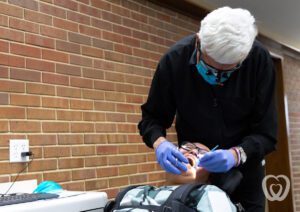Offer insights into effective communication methods that foster trust and ease anxiety in patients with disabilities. In the dental chair, patients often feel vulnerable—exposed not just physically but emotionally. Whether it’s fear of pain, financial concerns, or past negative experiences, building trust becomes essential for a positive patient-dentist relationship. For dentists, trust isn’t just good ethics—it’s good business. Trusted practitioners see better patient retention, more referrals, and improved treatment outcomes.
Here are some practical communication strategies to help you establish and strengthen trust with your patients:
1. For patients with a disability, provide them with the My Dental Care Passport to fill out before the appointment so you have a grasp on the individual’s needs, ways to communicate and what makes the person comfortable. Show empathy when treating patients with different needs.
2. Practice Active Listening
Patients want to feel heard. Before you begin any treatment, listen without interruption. Use open-ended questions like:
“Can you tell me more about what’s been bothering you?”
After they respond, paraphrase what you’ve heard to show understanding and clarify any uncertainties. This shows that you value their input and are genuinely interested in their well-being.
3. Simplify the Jargon
Dental terminology can be overwhelming or intimidating. Avoid overcomplicated explanations. Instead of saying, “You have a distal occlusal caries on your second molar,” try:
“You have a cavity in the back tooth on the lower right side.”
Using plain language helps patients understand their diagnosis and treatment options, which builds confidence in your care.
4. Explain the “Why” Behind the Treatment
Patients are more likely to follow through with treatment when they understand why it’s needed. Visual aids like X-rays or diagrams can help bridge this gap.
Explain how each procedure will help prevent further issues, reduce discomfort, or improve their oral health long term.
5. Respect Time and Follow Through
Running late happens, but chronic delays signal to patients that their time isn’t valued. For individuals with a disability, waiting too long can cause anxiety or frustration. When delays occur, communicate clearly and apologize.
Follow up after significant procedures with a phone call or email to check on their recovery—this small act builds loyalty and shows that you care beyond the appointment.
6. Maintain a Consistent and Friendly Demeanor
Consistency builds comfort. A friendly greeting, a familiar face at the front desk, and a warm environment contribute to a feeling of reliability.
Encourage your staff to be courteous and patient-focused—trust is a team effort.
Dentistry is as much about people as it is about teeth. By prioritizing communication and empathy, you create a patient-centered practice where trust is the foundation. This not only improves clinical outcomes but turns first-time visitors into lifelong advocates. Visit https://pathwaystooralhealth.org/dental-providers/ for practical tools for dental teams to enhance patient care and to build confidence in treating individuals with disabilities.




